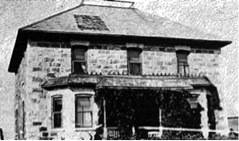
When the Richview School needed a larger location for an extra special Christmas concert they would hold it at the Anchorage, conveniently located nearby. The school still stands almost secluded at the back of a grassy plot along Highway 3 a couple of kilometres west of the #10 corner. The Anchorage is, unfortunately, long gone.
The Anchorage was not, as one might expect when first hearing of it, a public hall. It was a private home. A somewhat special private home to be sure; forty by forty-four feet, of prairie stone, with an imposing façade highlighted by a verandah extended between the two bay windows. It was situated at the top of a gentle rise facing south with large windows offering a commanding view of Turtle Mountain and overlooking a rolling prairie landscape in every direction.
The interior was also exceptional as it included both a dining room and double parlour, along with the kitchen and storeroom on the main floor, and four large bedrooms above. It featured spacious closets in each bedroom and a "chamber", at the end of the upstairs hall – considered innovations at the time. Other “modern” features included gas lighting fixtures at a time when most prairie homes made do with candles and coal oil lamps, and a plaster-lined fieldstone cistern that was filled with rainwater funnelled from the eaves troughs through a galvanized pipe.
The brick-encased wood-burning hot air furnace had a cast iron door bearing the inscription, “Pat. 1888”. It even had a lightning rod system on the perimeter of the "widow's walk".
The Captain
One might expect that a person who named his dwelling, “The Anchorage” might have some sort of nautical background. Indeed, the house was built in 1898 for a real sea-faring man, Captain Robert Pendarvis Moore, who came to Boissevain to retire after a career with the Allan Line out of Liverpool and Glasgow. He had sent his two sons to the region in 1892, and they selected the location. The Captain, his wife, Adelaide, and the remainder of their large family, came in 1898. The Captain’s intention was to retire in proper British form, spending time on the “bridge”, (widow’s walk) surveying his “estate”, flying his Union Jack from the flagpole on the roof on all British holidays, and entertaining in style. It soon became, not only the dominant landmark of the Richview area, but the gathering place for afternoon teas and community meetings. Sadly, the Captain did not live long in it as he died in February 1899 at age 62. He did pass it on to his son Charles and it remained in the family until about 1930. After 1930, the house was often vacant, and used occasionally for public events. It met the fate of many surplus rural buildings. It was used as a granary and later fell into serious disrepair due to misuse, weather and vandalism. It was tom down in 1978 and the stones were used in a new dwelling. Thus ended the life of a house that held many pleasant memories for Captain Moore's family and the neighbourhood.

I can’t help but wonder if there might be a few alumni of Richview School out there who still remember holding their Christmas Concert in the big double parlour.
. . . . .
Author: Ken Storie
Sources:
Boissevain History Book Committee. Beckoning Hills Revisited. “Ours is a Goodly Heritage” Morton – Boissevain 1881 – 1981. Altona. Friesen Printing, 1981.
Photos: Above source, pp 176, 425.
